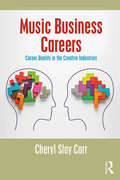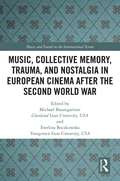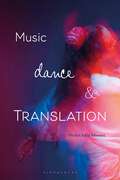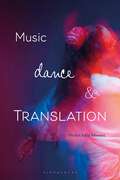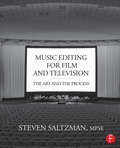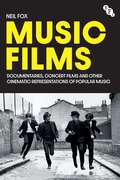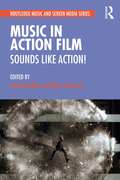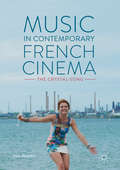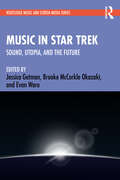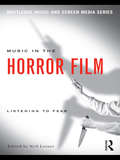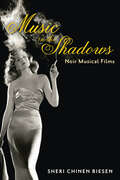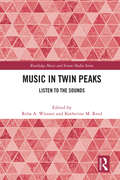- Table View
- List View
Music Business Careers: Career Duality in the Creative Industries (Routledge Research in Creative and Cultural Industries Management)
by Cheryl Slay CarrThe music industry offers the opportunity to pursue a career as either a creative (artist, producer, songwriter, etc.) or as a music business "logician" (artist manager, agent, entertainment attorney, venue manager, etc.). Though both vocational paths are integral to the industry’s success, the work of calling songs into existence or entertaining an audience differs from the administrative aspects of the business, such as operating an entertainment company. And while the daily activities of creatives may differ from those of the music business logician, the music industry careerist may sense a call to Career Duality, to work on both sides of the industry as a Career Dualist, a concept this book introduces, defines, and explores in the context of the music industry. This new volume speaks to the dilemma experienced by those struggling with career decisions involving whether to work in the industry using their analytical abilities, or to work as a creative, or to do both. The potential financial challenges encountered in working in the industry as an emerging artist may necessitate maintaining a second and simultaneous occupation (possibly outside the industry) that offers economic survival. However, this is not Career Duality. Likewise, attending to the business affairs that impact all creatives is not Career Duality. Rather, Career Duality involves the deliberate pursuit of a dual career as both a music industry creative and music business logician, which is stimulated by the drive to express dual proclivities that are simultaneously artistic and analytical. By offering a Career Duality model and other constructs, examining research on careers, calling, authenticity and related concepts, and providing profiles of music industry dualists, this book takes readers on a journey of self-exploration and offers insights and recommendations for charting an authentic career path. This is a practical examination for not only music industry professionals and the entertainment industry, but for individuals interested in expressing both the analytical and artistic self in the context of career.
Music, Collective Memory, Trauma, and Nostalgia in European Cinema after the Second World War (Music and Sound on the International Screen)
by Michael Baumgartner Ewelina BoczkowskaIn the wake of World War II, the arts and culture of Europe became a site where the devastating events of the 20th century were remembered and understood. Exploring one of the most integral elements of the cinematic experience—music—the essays in this volume consider the numerous ways in which post-war European cinema dealt with memory, trauma and nostalgia, showing how the music of these films shaped the representation of the past. The contributors consider films from the United Kingdom, Poland, the Soviet Union, France, Italy, Germany, Sweden, Austria, and the Netherlands, providing a diverse and well-rounded understanding of film music in the context of historical memory. Memory is often underrepresented within scholarly musical studies, with most of these applications found in the disciplines of ethnomusicology, popular music studies, music cognition, and psychology and music therapy. Likewise, trauma has mainly been studied in relation to music in only a few historical contexts, while nostalgia has attracted even less academic attention. In three parts, this volume addresses each area of study as it relates to the music of European cinema from 1945 to 1989, applying an interdisciplinary approach to investigate how films use music to negotiate the precarious relationships we maintain with the past. Music, Collective Memory, Trauma, and Nostalgia in European Cinema after the Second World War offers compelling arguments as to what makes music such a powerful medium for memory, trauma and nostalgia.
Music, Collective Memory, Trauma, and Nostalgia in European Cinema after the Second World War (Music and Sound on the International Screen)
by Michael Baumgartner Ewelina BoczkowskaIn the wake of World War II, the arts and culture of Europe became a site where the devastating events of the 20th century were remembered and understood. Exploring one of the most integral elements of the cinematic experience—music—the essays in this volume consider the numerous ways in which post-war European cinema dealt with memory, trauma and nostalgia, showing how the music of these films shaped the representation of the past. The contributors consider films from the United Kingdom, Poland, the Soviet Union, France, Italy, Germany, Sweden, Austria, and the Netherlands, providing a diverse and well-rounded understanding of film music in the context of historical memory. Memory is often underrepresented within scholarly musical studies, with most of these applications found in the disciplines of ethnomusicology, popular music studies, music cognition, and psychology and music therapy. Likewise, trauma has mainly been studied in relation to music in only a few historical contexts, while nostalgia has attracted even less academic attention. In three parts, this volume addresses each area of study as it relates to the music of European cinema from 1945 to 1989, applying an interdisciplinary approach to investigate how films use music to negotiate the precarious relationships we maintain with the past. Music, Collective Memory, Trauma, and Nostalgia in European Cinema after the Second World War offers compelling arguments as to what makes music such a powerful medium for memory, trauma and nostalgia.
Music \= Cultures in Contact: Convergences and Collisions (Musicology)
by Margaret J. Kartomi Stephen BlumFirst Published in 1995. Routledge is an imprint of Taylor & Francis, an informa company.
Music \= Cultures in Contact: Convergences and Collisions (Musicology #16)
by Margaret J. Kartomi Stephen BlumFirst Published in 1995. Routledge is an imprint of Taylor & Francis, an informa company.
Music, Dance and Translation
by Helen Julia MinorsHow is music affected by its translation, interpretation and adaptation with, through, and by dance? How might notation of dance and music act as a form of translation? How does music influence the creation of dance? How might dance and music be understood to exchange and transfer their content, sense and process during both the creative process and the interpretative process? Bringing together chapters that explore theory and practice, this book questions the process and role translation has to play in the context of music and dance. It provides a range of case studies across this interdisciplinary field, and is not restricted by genre, style or cultural location. As one of very few volumes to explore translation in relation to music and to overtly tackle this topic in terms of dance, it moves the argument from a broad notion of text and translation, to think critically about the sound and movement arts of music and dance, using translation as a model to better understand the collaboration of these art forms.
Music, Dance and Translation
How is music affected by its translation, interpretation and adaptation with, through, and by dance? How might notation of dance and music act as a form of translation? How does music influence the creation of dance? How might dance and music be understood to exchange and transfer their content, sense and process during both the creative process and the interpretative process? Bringing together chapters that explore theory and practice, this book questions the process and role translation has to play in the context of music and dance. It provides a range of case studies across this interdisciplinary field, and is not restricted by genre, style or cultural location. As one of very few volumes to explore translation in relation to music and to overtly tackle this topic in terms of dance, it moves the argument from a broad notion of text and translation, to think critically about the sound and movement arts of music and dance, using translation as a model to better understand the collaboration of these art forms.
Music Editing for Film and Television: The Art and the Process
by Steven SaltzmanMaking music for the movies is a complicated, involved, and challenging process. Music Editing for Film and Television covers the practical skills needed to successfully hone your craft. Through an overview of the music editing process, this book will equip you with detailed techniques to solve musical problems encountered during editing. An abundance of interviews with well-known professionals provide a wide range of perspectives on music editing for film, while special features address an array of projects, from a low-budget documentary, to a Hollywood blockbuster, to indie projects.
Music Editing for Film and Television: The Art and the Process
by Steven SaltzmanMaking music for the movies is a complicated, involved, and challenging process. Music Editing for Film and Television covers the practical skills needed to successfully hone your craft. Through an overview of the music editing process, this book will equip you with detailed techniques to solve musical problems encountered during editing. An abundance of interviews with well-known professionals provide a wide range of perspectives on music editing for film, while special features address an array of projects, from a low-budget documentary, to a Hollywood blockbuster, to indie projects.
Music Festivals: An Essential Pocket Guide to Surviving in Style
by Tamsin KingFestivals come in every shape and size, but they are all a wonderful opportunity to have an awesome party! This guide is packed with tips to help you make the most of your festival experience, whether it’s at a sprawling tent city or a small but perfectly curated boutique festival.
Music Films: Documentaries, Concert Films and Other Cinematic Representations of Popular Music
by Neil FoxIn Music Films, Neil Fox considers a broad range of music documentaries, delving into their cinematic style, political undertones, racial dynamics, and gender representations, in order to assess their role in the cultivation of myth.Combining historical and critical analyses, and drawing on film and music criticism, Fox examines renowned music films such as A Hard Day's Night (1964), Dig! (2004), and Amazing Grace (2006), critically lauded works like Milford Graves Full Mantis (2018) and Mistaken for Strangers (2013), and lesser-studied films including Jazz on a Summer's Day (1959) and Ornette: Made in America (1985). In doing so, he offers a comprehensive overview of the genre, situating these films within their wider cultural contexts and highlighting their formal and thematic innovations.Discussions in the book span topics from concert filmmaking to music production, the music industry, touring, and filmic representations of authenticity and truth. Overall, Music Films traces the evolution of the genre, highlighting its cultural significance and connection to broader societal phenomena.
Music Films: Documentaries, Concert Films and Other Cinematic Representations of Popular Music
by Neil FoxIn Music Films, Neil Fox considers a broad range of music documentaries, delving into their cinematic style, political undertones, racial dynamics, and gender representations, in order to assess their role in the cultivation of myth.Combining historical and critical analyses, and drawing on film and music criticism, Fox examines renowned music films such as A Hard Day's Night (1964), Dig! (2004), and Amazing Grace (2006), critically lauded works like Milford Graves Full Mantis (2018) and Mistaken for Strangers (2013), and lesser-studied films including Jazz on a Summer's Day (1959) and Ornette: Made in America (1985). In doing so, he offers a comprehensive overview of the genre, situating these films within their wider cultural contexts and highlighting their formal and thematic innovations.Discussions in the book span topics from concert filmmaking to music production, the music industry, touring, and filmic representations of authenticity and truth. Overall, Music Films traces the evolution of the genre, highlighting its cultural significance and connection to broader societal phenomena.
Music in Action Film: Sounds Like Action!
by James Buhler Mark DurrandMusic in Action Film is the first volume to address the central role of music and sound in action film—arguably the most dominant form of commercial cinema today. Bringing together 15 essays by established and emerging scholars, the book encompasses both Hollywood blockbusters and international films, from classic works such as The Seven Samurai to contemporary superhero franchises. The contributors consider action both as genre and as a mode of cinematic expression, in chapters on evolving musical conventions; politics, representation, and identity; musical affect and agency; the functional role of music and sound design in action film; and production technologies. Breaking new critical ground yet highly accessible, this book will be of interest to students and scholars of music and film studies.
Music in Action Film: Sounds Like Action!
by James Buhler Mark DurrandMusic in Action Film is the first volume to address the central role of music and sound in action film—arguably the most dominant form of commercial cinema today. Bringing together 15 essays by established and emerging scholars, the book encompasses both Hollywood blockbusters and international films, from classic works such as The Seven Samurai to contemporary superhero franchises. The contributors consider action both as genre and as a mode of cinematic expression, in chapters on evolving musical conventions; politics, representation, and identity; musical affect and agency; the functional role of music and sound design in action film; and production technologies. Breaking new critical ground yet highly accessible, this book will be of interest to students and scholars of music and film studies.
Music in Contemporary French Cinema: The Crystal-Song
by Phil PowrieThis book explores composed scores and pre-existing music in French cinema from 1985 to 2015 so as to identify critical musical moments. It shows how heritage films construct space through music, generating what Powrie calls “third space music,” while also working to contain the strong women characters found in French heritage films through the use of leitmotifs and musical cues. He analyses fiction films in which the protagonists perform at the piano, showing how musical performance supports the performance of gender. Building on aspects of musical performance, and in particular the use of songs performed in films, Powrie uses a database of 300 films since 2010 to theorize the intervention of music at critical moments as a “crystal-song”. Applying Roland Barthes’s concept of the “punctum” and Gille Deleuze’s concept of the “crystal-image,” Powrie establishes the importance of the crystal-song, which reconfigures time as a crystallization of past, present and future.
Music in Contemporary French Cinema: The Crystal-Song
by Phil PowrieThis book explores composed scores and pre-existing music in French cinema from 1985 to 2015 so as to identify critical musical moments. It shows how heritage films construct space through music, generating what Powrie calls “third space music,” while also working to contain the strong women characters found in French heritage films through the use of leitmotifs and musical cues. He analyses fiction films in which the protagonists perform at the piano, showing how musical performance supports the performance of gender. Building on aspects of musical performance, and in particular the use of songs performed in films, Powrie uses a database of 300 films since 2010 to theorize the intervention of music at critical moments as a “crystal-song”. Applying Roland Barthes’s concept of the “punctum” and Gille Deleuze’s concept of the “crystal-image,” Powrie establishes the importance of the crystal-song, which reconfigures time as a crystallization of past, present and future.
Music in Films about the Shoah: Commemoration, Comfort, Provocation (Palgrave Studies in Audio-Visual Culture)
by Elias BernerThis book focuses on the aural and musical sphere of fictional audio-visual reconstructions of the Holocaust, a defining event in the history of the 20th century. Musicology has seen an increasing number of works on the function of film music and the construction of identity in media contexts in recent years. This project analyses the use of music in feature films about the Shoah. The analysis of 'the sound of Nazi violence', as well as the escape from and resistance against it, not only reveals a lot about the construction of the filmic characters' emotive states, but also tells us more about our own relationship to the past. The author understands the soundtrack of these films as an affective mediator of time, which connects filmic representations of the past with the present. Analysis focuses on the soundtracks of four films: Schindler's List, The Pianist, Taking Sides and Inglourious Basterds.
Music in Star Trek: Sound, Utopia, and the Future
by Jessica Getman Brooke McCorkle Okazaki Evan WareThe tensions between utopian dreams and dystopian anxieties permeate science fiction as a genre, and nowhere is this tension more evident than in Star Trek. This book breaks new ground by exploring music and sound within the Star Trek franchise across decades and media, offering the first sustained look at the role of music in shaping this influential series. The chapters in this edited collection consider how the aural, visual, and narrative components of Star Trek combine as it constructs and deconstructs the utopian and dystopian, shedding new light on the series’ political, cultural, and aesthetic impact. Considering how the music of Star Trek defines and interprets religion, ideology, artificial intelligence, and more, while also considering fan interactions with the show’s audio, this book will be of interest to students and scholars of music, media studies, science fiction, and popular culture.
Music in Star Trek: Sound, Utopia, and the Future
by Jessica Getman Brooke McCorkle Okazaki Evan WareThe tensions between utopian dreams and dystopian anxieties permeate science fiction as a genre, and nowhere is this tension more evident than in Star Trek. This book breaks new ground by exploring music and sound within the Star Trek franchise across decades and media, offering the first sustained look at the role of music in shaping this influential series. The chapters in this edited collection consider how the aural, visual, and narrative components of Star Trek combine as it constructs and deconstructs the utopian and dystopian, shedding new light on the series’ political, cultural, and aesthetic impact. Considering how the music of Star Trek defines and interprets religion, ideology, artificial intelligence, and more, while also considering fan interactions with the show’s audio, this book will be of interest to students and scholars of music, media studies, science fiction, and popular culture.
Music in the Horror Film: Listening to Fear
by Neil LernerMusic in Horror Film is a collection of essays that examine the effects of music and its ability to provoke or intensify fear in this particular genre of film. Frightening images and ideas can be made even more intense when accompanied with frightening musical sounds, and music in horror film frequently makes its audience feel threatened and uncomfortable through its sudden stinger chords and other shock effects. The essays in this collection address the presence of music in horror films and their potency within them. With contributions from scholars across the disciplines of music and film studies, these essays delve into blockbusters like The Exorcist, The Shining, and The Sixth Sense together with lesser known but still important films like Carnival of Souls and The Last House on the Left. By leading us with the ear to hear these films in new ways, these essays allow us to see horror films with fresh eyes.
Music in the Horror Film: Listening to Fear
by Neil LernerMusic in Horror Film is a collection of essays that examine the effects of music and its ability to provoke or intensify fear in this particular genre of film. Frightening images and ideas can be made even more intense when accompanied with frightening musical sounds, and music in horror film frequently makes its audience feel threatened and uncomfortable through its sudden stinger chords and other shock effects. The essays in this collection address the presence of music in horror films and their potency within them. With contributions from scholars across the disciplines of music and film studies, these essays delve into blockbusters like The Exorcist, The Shining, and The Sixth Sense together with lesser known but still important films like Carnival of Souls and The Last House on the Left. By leading us with the ear to hear these films in new ways, these essays allow us to see horror films with fresh eyes.
Music in the Shadows: Noir Musical Films
by Sheri Chinen BiesenSmoke. Shadows. Moody strains of jazz. Welcome to the world of "noir musical" films, where tormented antiheroes and hard-boiled musicians battle obsession and struggle with their music and ill-fated love triangles. Sultry divas dance and sing the blues in shrouded nightclubs. Romantic intrigue clashes with backstage careers. In her pioneering study, Music in the Shadows, film noir expert Sheri Chinen Biesen explores musical films that use film noir style and bluesy strains of jazz to inhabit a disturbing underworld and reveal the dark side of fame and the American Dream. While noir musical films like A Star Is Born include musical performances, their bleak tone and expressionistic aesthetic more closely resemble the visual style of film noir. Their narratives unfold behind a stark noir lens: distorted, erratic angles and imbalanced hand-held shots allow the audience to experience a tortured, disillusioned perspective.While many musicals glamorize the quest for the spotlight in Hollywood's star factory, brooding noir musical films such as Blues in the Night, Gilda, The Red Shoes, West Side Story, and Round Midnight stretch the boundaries of film noir and the musical as film genres collide. Deep shadows, dim lighting, and visual composition evoke moodiness, cynicism, pessimism, and subjective psychological points of view.As in her earlier study of film noir, Blackout: World War II and the Origins of Film Noir, Biesen draws on extensive primary research in studio archives to situate her examination within a historical, industrial, and cultural context.
Music in the Shadows: Noir Musical Films
by Sheri Chinen BiesenSmoke. Shadows. Moody strains of jazz. Welcome to the world of "noir musical" films, where tormented antiheroes and hard-boiled musicians battle obsession and struggle with their music and ill-fated love triangles. Sultry divas dance and sing the blues in shrouded nightclubs. Romantic intrigue clashes with backstage careers. In her pioneering study, Music in the Shadows, film noir expert Sheri Chinen Biesen explores musical films that use film noir style and bluesy strains of jazz to inhabit a disturbing underworld and reveal the dark side of fame and the American Dream. While noir musical films like A Star Is Born include musical performances, their bleak tone and expressionistic aesthetic more closely resemble the visual style of film noir. Their narratives unfold behind a stark noir lens: distorted, erratic angles and imbalanced hand-held shots allow the audience to experience a tortured, disillusioned perspective.While many musicals glamorize the quest for the spotlight in Hollywood's star factory, brooding noir musical films such as Blues in the Night, Gilda, The Red Shoes, West Side Story, and Round Midnight stretch the boundaries of film noir and the musical as film genres collide. Deep shadows, dim lighting, and visual composition evoke moodiness, cynicism, pessimism, and subjective psychological points of view.As in her earlier study of film noir, Blackout: World War II and the Origins of Film Noir, Biesen draws on extensive primary research in studio archives to situate her examination within a historical, industrial, and cultural context.
Music in Twin Peaks: Listen to the Sounds
by Katherine M. ReedIn this edited volume, contributors explore an essential element of the influential television series Twin Peaks: the role of music and sound. From its debut in 1990 to its return to television in 2017, Twin Peaks has amassed a cult following, and inspired myriad scholarly studies. This collection considers how the music and sound design not only create the ambience of this ground-breaking series, but function in the narrative, encouraging multiple interpretations. With chapters that consider how music shapes the relationship of audiences and fans to the story, the importance of sound design, and the symbolism embedded in the score, this book provides a range of perspectives for scholars of music and film studies, while giving fans new insight into an iconic television show.
Music in Twin Peaks: Listen to the Sounds
by Reba Wissner Katherine ReedIn this edited volume, contributors explore an essential element of the influential television series Twin Peaks: the role of music and sound. From its debut in 1990 to its return to television in 2017, Twin Peaks has amassed a cult following, and inspired myriad scholarly studies. This collection considers how the music and sound design not only create the ambience of this ground-breaking series, but function in the narrative, encouraging multiple interpretations. With chapters that consider how music shapes the relationship of audiences and fans to the story, the importance of sound design, and the symbolism embedded in the score, this book provides a range of perspectives for scholars of music and film studies, while giving fans new insight into an iconic television show.
